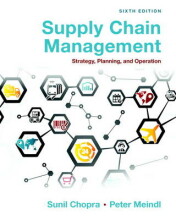Summary: Supply Chain Management Strategy, Planning, And Operation | 9780133800203 | Sunil Chopra, et al
- This + 400k other summaries
- A unique study and practice tool
- Never study anything twice again
- Get the grades you hope for
- 100% sure, 100% understanding
Read the summary and the most important questions on Supply Chain Management Strategy, Planning, and Operation | 9780133800203 | Sunil Chopra; Peter Meindl
-
3.5 Inventory
This is a preview. There are 3 more flashcards available for chapter 3.5
Show more cards here -
Why does inventory exist?
because of a mismatch between supply and demand, most of the time an intentional mismatch -> more economical to manufacture in large lots and then store for future sales -
How to handle inventory as cheaper costs
To handle inventory at cheaper costs, you can try techniques like bulk purchasing to get discounts, reducing excess inventory levels to avoid storage costs, implementing just-in-time inventory management to minimize holding costs, and negotiating better prices with suppliers. Additionally, you can also focus on reducing waste and improving inventory turnover to maximize efficiency and keep costs low. -
How to successfully negotiate with suppliers and what are key strategies?
To successfully negotiate with suppliers, begin by conducting research to understand market prices and your leverage. Clearly communicate your needs and build a strong relationship with the supplier. Key strategies include setting clear objectives, being willing to walk away if necessary, and seeking win-win solutions. Also, consolidating volume, seeking long-term commitments, and exploring alternative options can help improve negotiation outcomes. -
What is Cycle Inventory?
average amount of inventory used to satisfy demand between receipts of supplier shipments -
What is Seasonal Inventory?
Built up inventory to counter predictable seasonal variability in demand. It is build up in periods with low demand and stored for periods with high demand. -
4 Designing Distribution Networks and Applications to Online Sales
-
4.2 Factors influencing distribution network design
This is a preview. There are 2 more flashcards available for chapter 4.2
Show more cards here -
Along which two dimensions should the performance of a distribution network be evaluated?
- value provided to the customer
- Cost of meeting customer needs
-
Give 4 supply chain costs that are affected when changing the distribution network design
- Inventories
- Transportation
- Facilities and handling
- Information
-
What are the Total logistics costs?
the sum of the inventory, transportation and facility costs for a supply chain network. -
4.3 Design options for a distribution network
This is a preview. There are 1 more flashcards available for chapter 4.3
Show more cards here -
Which two key decisions should managers make when designing a distribution network?
- Will product be delivered to the customer location or picked up from prearranged site?
- Will product flow through an intermediary location?
-
4.5 Distribution Networks in Practise
-
Give 4 things to take into account when managing a distribution network
- The ownership structure of the distribution network can have as big an impact as the type of distribution network
- It is important to have adaptable distribution networks
- Products price, commoditization, and criticality affect the type of distribution system preffered by customers
- Integrate the Internet with the existing physical network
- Higher grades + faster learning
- Never study anything twice
- 100% sure, 100% understanding
Topics related to Summary: Supply Chain Management Strategy, Planning, And Operation
-
Network Design in the Supply Chain
-
Demand Forecasting in a Supply Chain
-
Managing Economies of Scale in a Supply Chain
-
Managing Uncertainty in a Supply Chain
-
Determining the Optimal Level of Product Availability - Factors Affecting Optimal Level of Product Availability
-
Transportation in a Supply Chain - Design options for a transportation network
-
Transportation in a Supply Chain - Trade-Offs in transportation Design
-
Transportation in a Supply Chain - Tailored Transportation
-
Sourcing Decisions in a Supply Chain - In-House or Outsource
-
Sourcing Decisions in a Supply Chain - Total cost of ownership
-
Sourcing Decisions in a Supply Chain - Sharing risk and reward in the supply chain
































